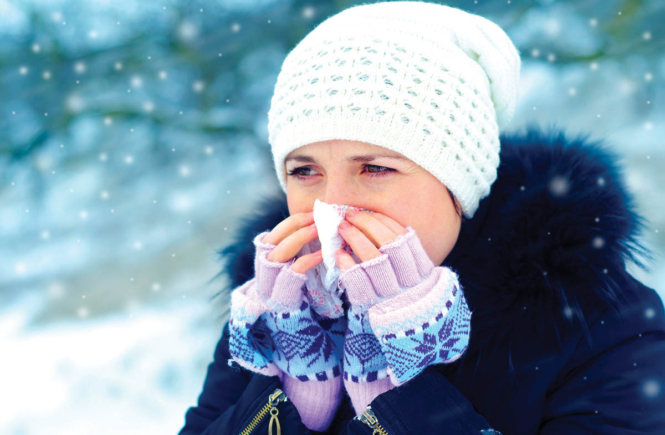As the winter months set in on the Shore, PRMC officials remind you to beware of these potential dangers
Winter is fast approaching, and so are the hazards brought on by the cold weather and flu season. Here are some common health hazards and tips to make sure you don’t fall ill or become injured.
1. Slips, Trips and Falls
The season’s slippery conditions are one of the most common causes of injury in wintertime. Jill Stone, Director of Physical Medicine for Peninsula Regional Medical Center, says her team sees a lot of patients who have been injured due to slips and falls.
“January and February are when we see a lot of hip fractures and shoulder fractures, when people reach out to try to break the fall,” she said. “It’s very easy to slip on black ice. It can happen to anyone.” However, some common-sense precautions can make all the difference. “Appropriate footwear is very important,” Stone said.
Pack up the high heels or slick-bottomed flats and instead choose footwear with grip and tread. Walk slowly and deliberately — black ice can be hard to spot, so be sure of your footing. Don’t forget, slippery conditions are very dangerous for drivers, as well. Slow down and look for ice, especially on bridges and overpasses, when driving in chilly or snowy conditions. Stone also suggests making sure stairs are clear of ice and have solid railings to hold on to and that walkways are cleared and salted or sanded.
2. Shoveling Strain
Clearing your walkway might help prevent a nasty fall, but the process of shoveling snow requires caution, too. Stone says she follows the advice of the American Physical Therapy Association, which recommends lifting small loads of snow, rather than heavy shovelfuls, to avoid potential muscle strain. Lift with your knees, rather than bending and straining your lower back. Even more important, take frequent breaks. Sweat is a common sign that people are working hard and should slow down. Cold weather dampens that effect, so it’s very easy to overexert. Dr. Steven Hearne, Co-Medical Director of PRMC’s Guerrieri Heart & Vascular Institute, says cold weather puts an extra strain on the heart as it works to warm up the body. People with heart disease or high blood pressure should be very cautious about snow shoveling and other cold-weather exertions.
3. Exposure
When the weather is extremely cold, take appropriate precautions. Limit time spent outdoors and dress appropriately.
The CDC says dressing in layers helps:
• Start with an inner layer that will hold body heat and wick away moisture, such as wool, silk or polypropylene.
• Cover that with an insulation layer, such as fleece, wool or down.
• Finally, have a tightly woven outer layer that will keep you dry and protect you from wind. Covering extremities is vitally important, so invest in a good pair of mittens or gloves, and don’t forget your hat, scarf and a pair of warm, moisture-wicking socks. Shivering, exhaustion, confusion and drowsiness can be signs of hypothermia. Keep an eye on infants and the elderly, who are most likely to develop hypothermia. A body temperature lower than 95 degrees is an emergency — get medical attention immediately.
4. Respiratory
Cold air is very dry, which can trigger reactions in people with respiratory ailments, says R.J. Wilkinson, BSRC, RRT, Director for Respiratory Services at PRMC.
“A humidifier is beneficial to have in the home for those who have respiratory complications, especially those with asthma and COPD.” Wilkinson also recommends covering your nose and mouth with a scarf when going outside, as the cold air can exacerbate breathing problems.
“If prescribed a rescue inhaler, such as Albuterol, keep it close by for immediate use when needed,” Wilkinson said. “Always remember to use a spacer for maximum effectiveness.”
5. Cold & Flu
Colds and the flu are prevalent in winter as people crowd together indoors.
“To prevent the spread of germs and greatly decrease your chances of becoming sick, it is very important to wash your hands frequently,” Wilkinson said.
While colds are unpleasant and an inconvenience, influenza, which shares many symptoms, can have very serious complications. It’s important to immunize children and seniors especially, as complications are more common in these age groups. How do you know if it’s the flu or a common cold? Flu symptoms are more likely to have a sudden onset, while colds come on more gradually. Fever, chills, aches and fatigue are common in flu but less common in colds.
Whether you have a cold or flu, if the symptoms are milder, you can treat them at home with plenty of fluids, rest and over-the-counter medications. Antiviral medication may be appropriate for some people, especially children and seniors — call your doctor for advice. If you think you or a loved one may have the flu, look out for signs of emergency complications.

